Baby Teething Chart & Order
The Baby Teeth Eruption Chart: All You Need to Know
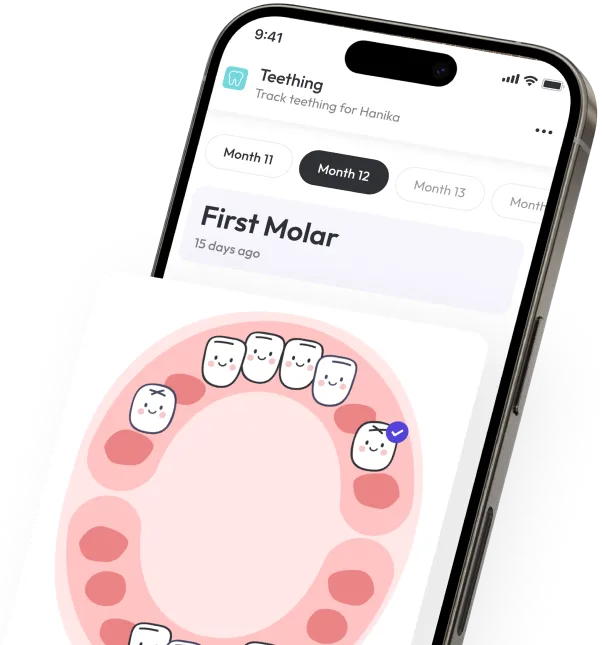
While the exact timing can vary differently from baby to to baby, a Baby Teething Chart or Baby Teeth Eruption Chart give us a rough timeline for when a particular baby tooth will push through the gums and erupt. Baby teeth chart or shedding chart also highlights the age at which the different teeth are likely to fall/shed. The baby teething chart help parents prepare for the baby teething needs and offers a child teething timeline to help you understand and manage this important milestone in your baby's life.
Teething is the process by which an infant's first teeth also called as the deciduous teeth, or popularly called as baby teeth or milk teeth appear through the gums. Baby's teeth typically arrives in pairs.
The ParentZ Baby Teething tracker allows parents to track your baby's teeth chart with eruption and shedding order. You can also use the app to track child vaccination schedules, growth, medications, sleep, growth and developmental milestones.
Baby teething chart: What order do baby teeth come in?
Use our easy to use interactive baby teething guide to know what order your baby's teeth are likely to come in and fall out.
Baby teeth: order of appearance and loss
What is Teething?
Teething is the process by which an infant's first teeth also called as the deciduous teeth, or popularly called as baby teeth or milk teeth appear through the gums. Baby's teeth typically arrives in pairs. Download The ParentZ Baby Growth & Health Tracker app now.
What is the order of teething in babies?
While the exact timing can vary from child to child, here's a general overview
- Lower Central Incisors (bottom front teeth): Usually emerge between 6-10 months.
- Upper Central Incisors (top front teeth): Typically appear between 8-12 months.
- Upper Lateral Incisors (teeth next to the top front teeth): Usually erupt around 9-13 months.
- Lower Lateral Incisors (teeth next to the bottom front teeth): Generally appear between 10-16 months.
- First Molars (back teeth): Typically emerge around 13-19 months.
- Canines (pointed teeth): Usually appear between 16-23 months.
- Second Molars (back teeth): Generally erupt around 23-33 months.
The eruption of teeth can cause some discomfort. Common signs of teething include drooling, gum swelling, irritability, and changes in eating or sleeping habits.
| Baby Upper Teeth | |||||||||
| Upper name | Position | Erupts | Lost/Shed | ||||||
|---|---|---|---|---|---|---|---|---|---|
| Central incisor | Upper | 8 - 12 Months | 6 - 7 Years | ||||||
| Lateral incisor | Upper | 9 - 13 Months | 7 - 8 Years | ||||||
| First molar | Upper | 13 - 19 Months | 9 - 11 Years | ||||||
| Second molar | Upper | 25 - 33 Months | 10 - 12 Years | ||||||
| Canine (cuspid) | Upper | 16 - 22 Months | 10 - 12 Years | ||||||
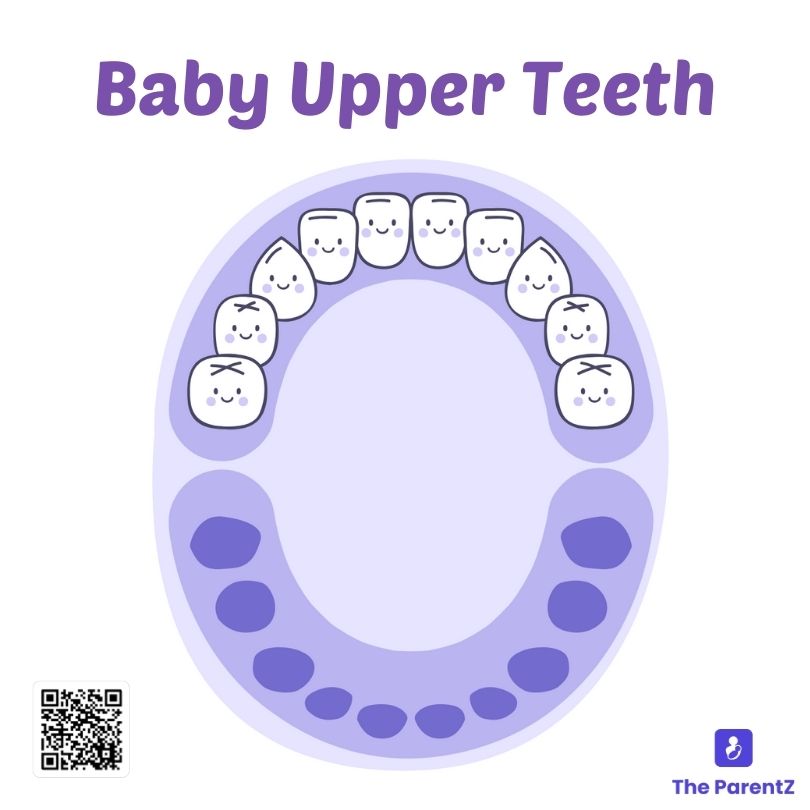
| Baby Lower Teeth | |||||||||
| Lower name | Position | Erupts | Lost/Shed | ||||||
|---|---|---|---|---|---|---|---|---|---|
| Central incisor | Lower | 6 - 10 Months | 6 - 7 Years | ||||||
| Lateral incisor | Lower | 10 - 16 Months | 7 - 8 Years | ||||||
| First molar | Lower | 14 - 18 Months | 9 - 11 Years | ||||||
| Second molar | Lower | 23 - 31 Months | 10 - 12 Years | ||||||
| Canine (cuspid) | Lower | 17 - 23 Months | 9 - 12 Years | ||||||
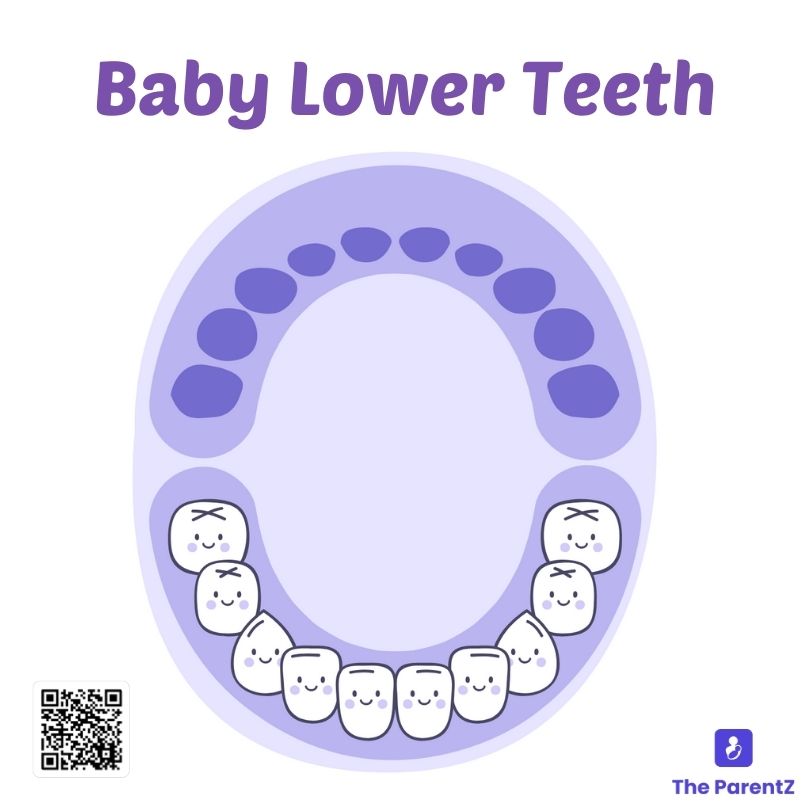
Lower Central Incisor - 6 to 10 Months
The baby's lower central incisors, in simple words bottom front milk teeth, typically begin to emerge between 6 and 10 months of age. This is typically one of the first signs of teething in infants.
Common Symptoms during this time
- Irritability,
- Increased drooling
- Desire to chew on objects as baby's teeth start to push through the gums
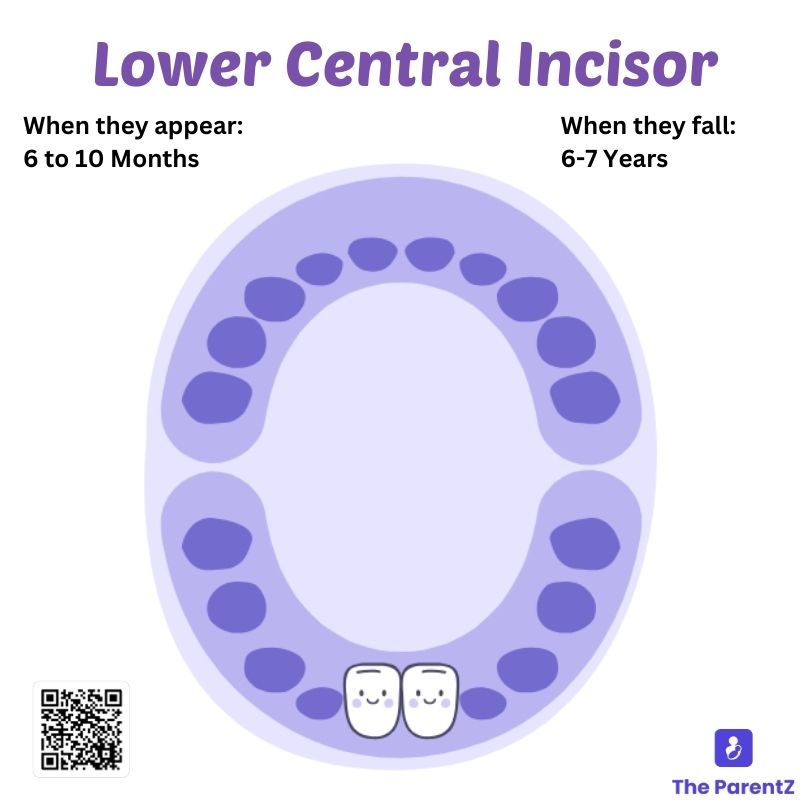
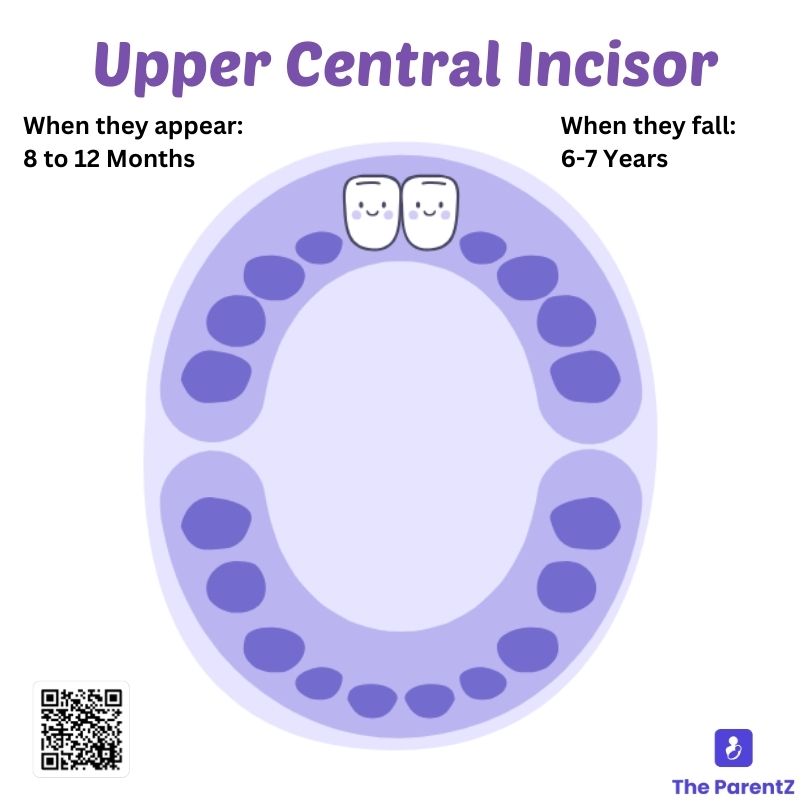
Upper Central Incisor - 8 to 12 Months
The baby's upper central incisors, in simple words top front milk teeth, usually begin to emerge between 8 and 12 months of age. This is also a significant milestone in baby's teething journey.
These teeth along with the lower central incisor teeth allows baby to start biting. Therefore these teeth play important role in baby moving from breastfeeding or bottle feeding to soft solid foods. These teeth allow them to both bite and tear/break food.
Upper Lateral Incisor - 9 to 13 Months
The upper lateral incisors typically emerge in babies between 9 to 13 months of age. These are the second set of teeth to come in on the upper jaw, located next to the central incisors (the two front teeth).
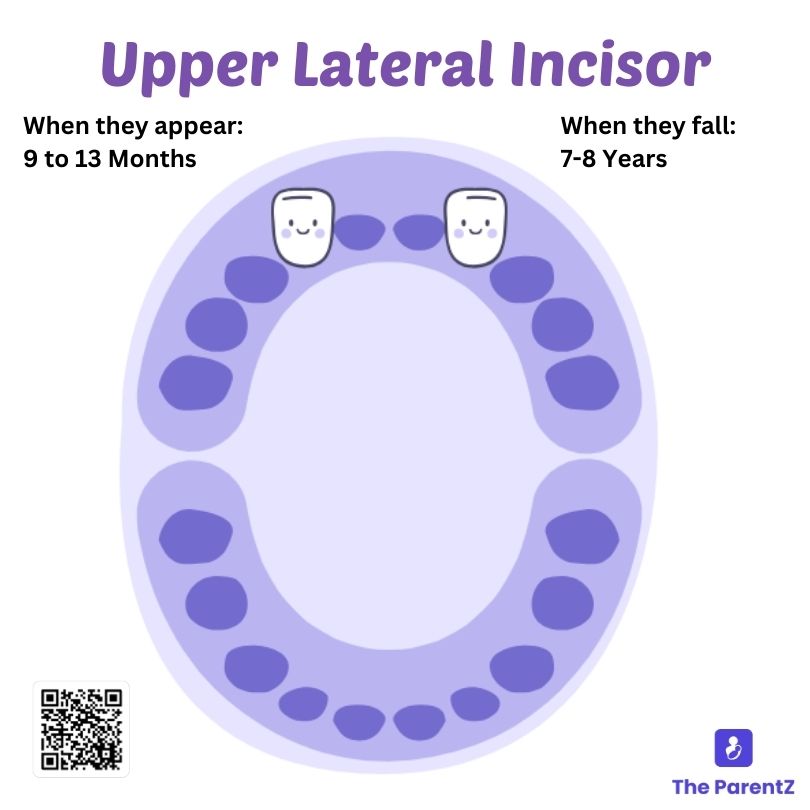
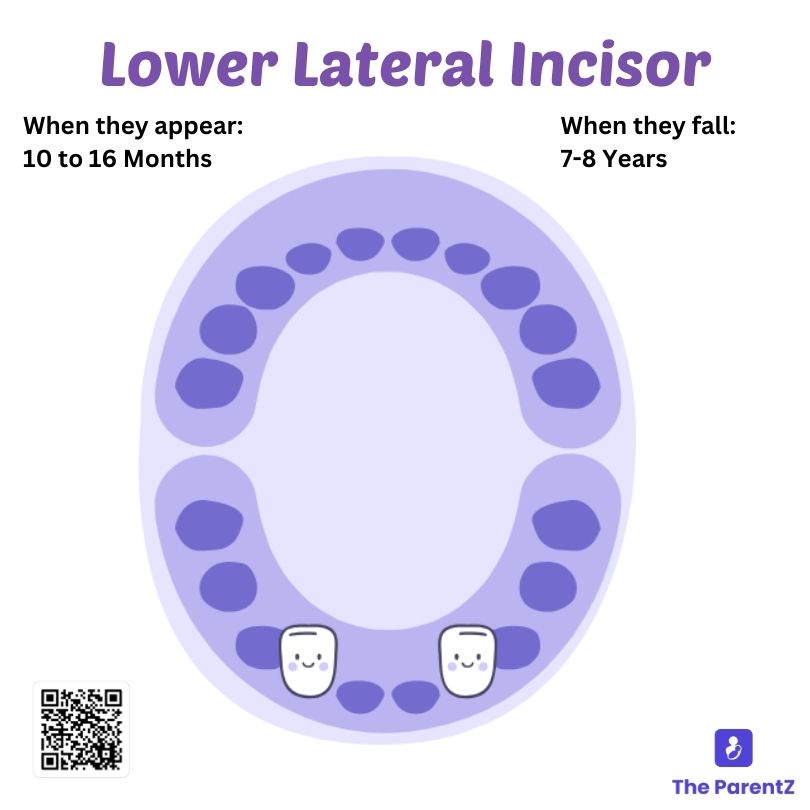
Lower Lateral Incisor - 10 to 16 Months
The baby lower lateral incisors usually emerge between 10 to 16 months of age. These are the second set of teeth in the lower jaw, appearing just beside the lower central incisors (the two front teeth).
Upper First Molars - 13 to 19 Months
The baby upper first molars typically emerge between 13 to 19 months of age. These are the first set of molars in the upper jaw and are located towards the back of the mouth, behind the upper lateral incisors.
First molars are important for helping your baby chew food, and they tend to be larger and more noticeable than the incisors or canines.
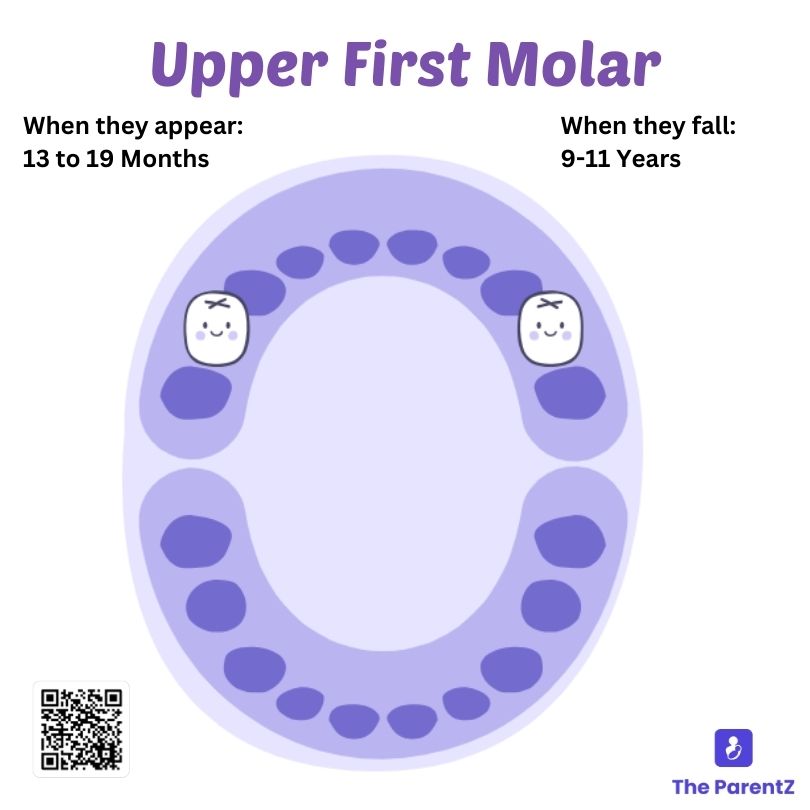
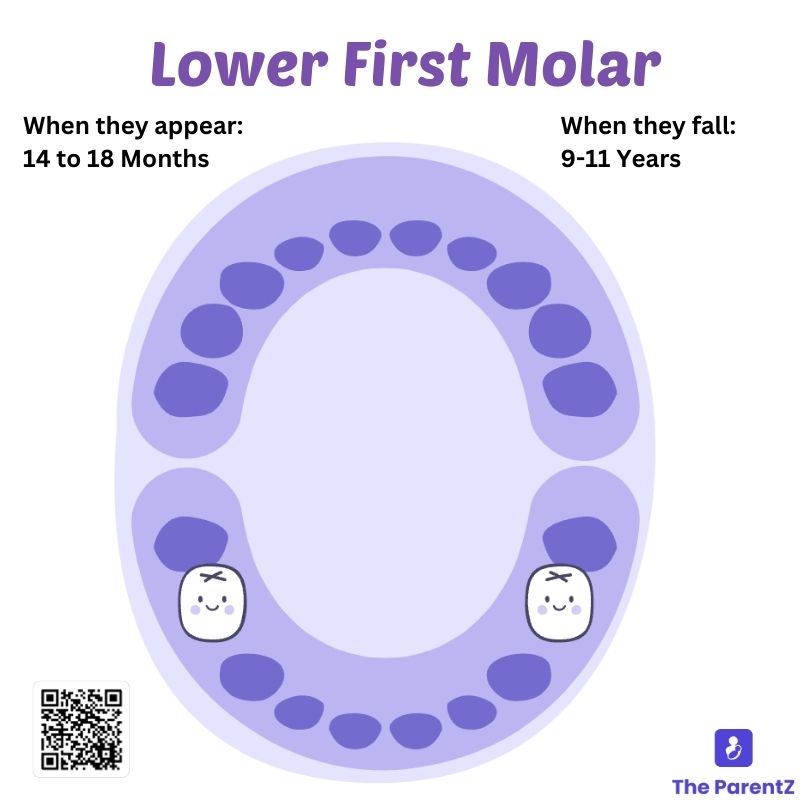
Lower First Molars - 14 to 18 Months
The baby lower first molars typically emerge between 14 to 18 months of age. These are the first molars in the lower jaw, located behind the lower lateral incisors and just in front of the canines.
The eruption of the lower first molars is a important milestone for your baby as these teeth are larger and help your baby with chewing and grinding food.
Upper Canines - 16 to 22 Months
The baby upper canines typically emerge between 16 to 22 months of age. These are the pointed teeth located just beside the upper lateral incisors.
The canines are important for helping your baby chew and tear food.
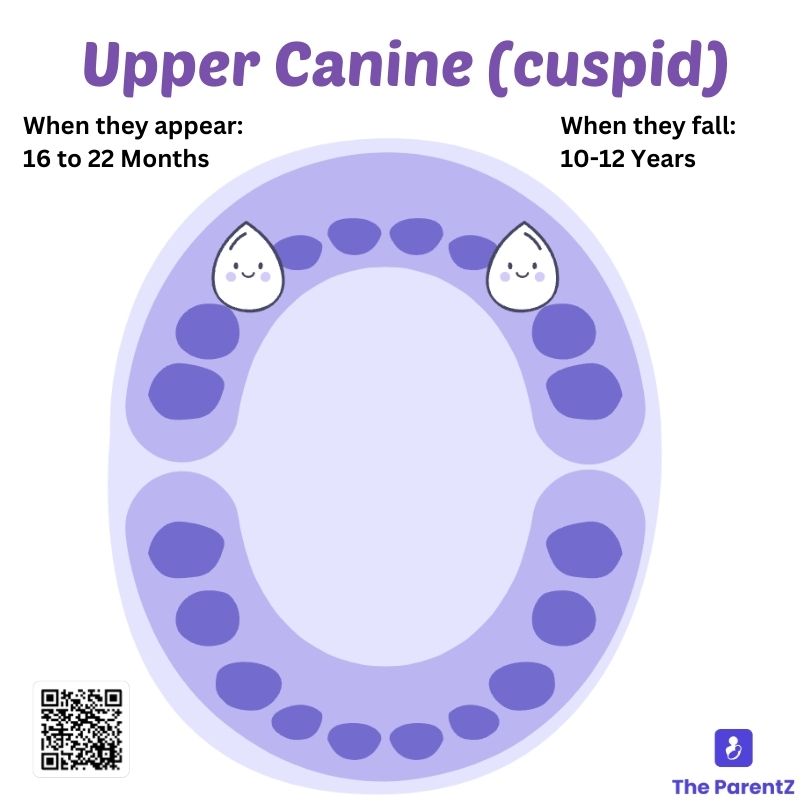
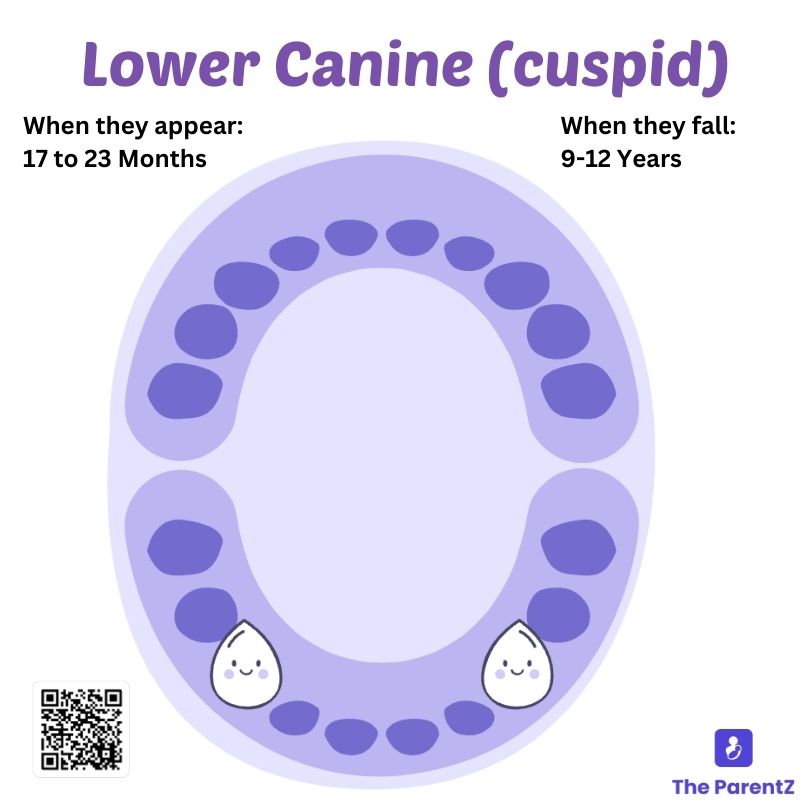
Lower Canines - 17 to 23 Months
The baby lower canines typically emerge between 17 to 23 months of age. These pointed teeth are located just beside the lower lateral incisors and are important for tearing food.
Lower Second Molars - 23 to 31 Months
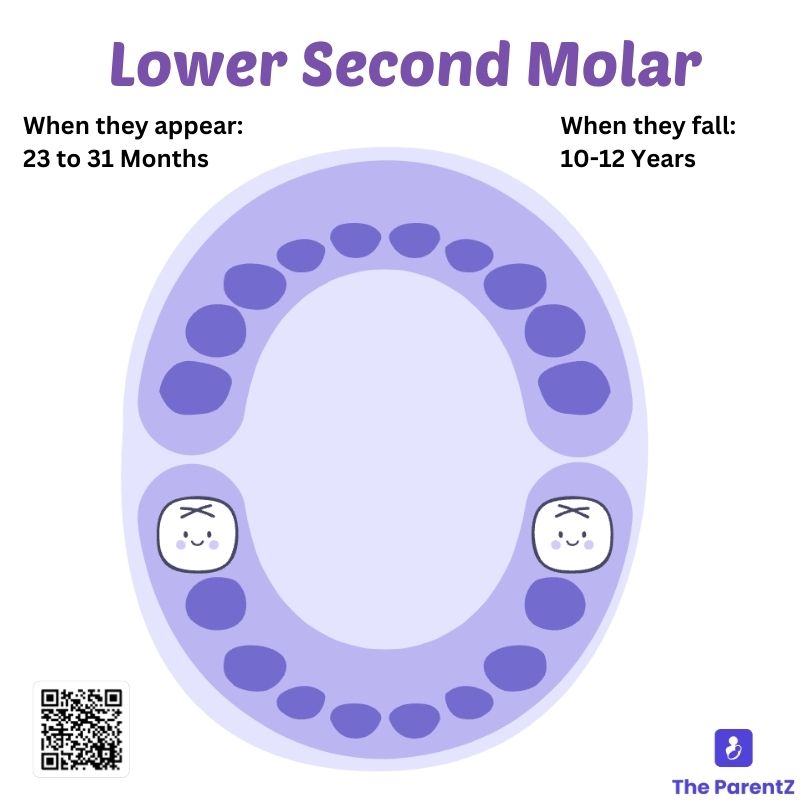

Upper Second Molars - 25 to 33 Months
Frequently Asked Questions
Find the answers to our most frequently asked questions
The Baby Teething Tracker is an online tool that helps parents monitor their baby’s teething progress by tracking when each tooth erupts and providing guidance on teething milestones. Download Baby Teething Chart & Tracker App to start tracking your kids teething, vaccinations and many more.
The Baby Teeth Chart visually represents the typical timeline for when different baby teeth appear. Parents can use it to track which teeth have come in and anticipate the next ones. Download Baby Teething Chart & Tracker App to track your baby's teething journey with our interactive user-friendly visualization of teething!
The tracker helps parents understand normal teething timelines, recognize any delays, and prepare for teething symptoms. It also provides insights into oral care and potential issues. Download Baby Teething Chart & Tracker App to track your kids teeth eruption.
Yes using The ParentZ Baby Teething Tracker you can track multiple babies, making this Baby Teething tracker must have tool for parents these days. Download Baby Teething Chart & Tracker App to start tracking your kids teething, vaccinations, breastfeeding, development milestones, medications and many more activities.
Most babies begin teething between 4 to 7 months, though some may start earlier or later. The first teeth to appear are usually the lower central incisors (lower front teeth) which usually emerge around 6 months of age.
To soothe teething discomfort, you can: Offer a teething toy or cold washcloth, Gently massage the gums with a clean finger, Use a doctor-approved teething gel (if recommended), Keep your baby hydrated and comfortable.
While the tracker itself does not relieve pain, it helps parents anticipate teething phases and prepare remedies in advance. It also provides tips for managing symptoms effectively. Download Baby Teething Chart & Tracker App to start tracking your kids teething, vaccinations and many more.
Common signs of teething include Increased drooling, Irritability or fussiness, Chewing on objects or fingers, Swollen or tender gums, Slight fever (low-grade), Difficulty sleeping, loss of appetite
Teething typically lasts from around 6 months to 3 years, as primary teeth continue to erupt gradually. However, individual babies may experience variations in timing.
The lower central incisors (bottom front teeth) are usually the first to appear, followed by the upper central incisors (top front teeth).
Teething may cause a slight rise in temperature, but it does not cause a high fever. If your baby has a temperature over 100.4°F (38°C), consult a doctor.
![[object Object]](/assets/img/theparentz_logo.png)





![[object Object]](/assets/img/download-app-vertical.png)